Maxillary Molars (highlighted material + objectives + quiz)
1/46
There's no tags or description
Looks like no tags are added yet.
Name | Mastery | Learn | Test | Matching | Spaced |
|---|
No study sessions yet.
47 Terms
Describe the functions of maxillary molars. (5 answers)
-mastication (grinding)
-maintenance of vertical dimension of face
-protect anterior teeth
-support cheeks (esthetics)
-Keep tongue confined within the confines of the arch
Which dimension is greater, mesiodistal or occlusocervical?
mesiodistal, Molars are the shortest teeth occlusocervically

Buccal or lingual view: all molar crowns have a ____(a.)____ to ____(b.)____ taper.
a. mesial
b. distal
Buccal or lingual view: distal cusps are __________ than mesial cusps.
shorter
Occlusal view: All molar crowns have a ___(a.)____ to ____(b.)____ taper.
a. mesial
b. distal
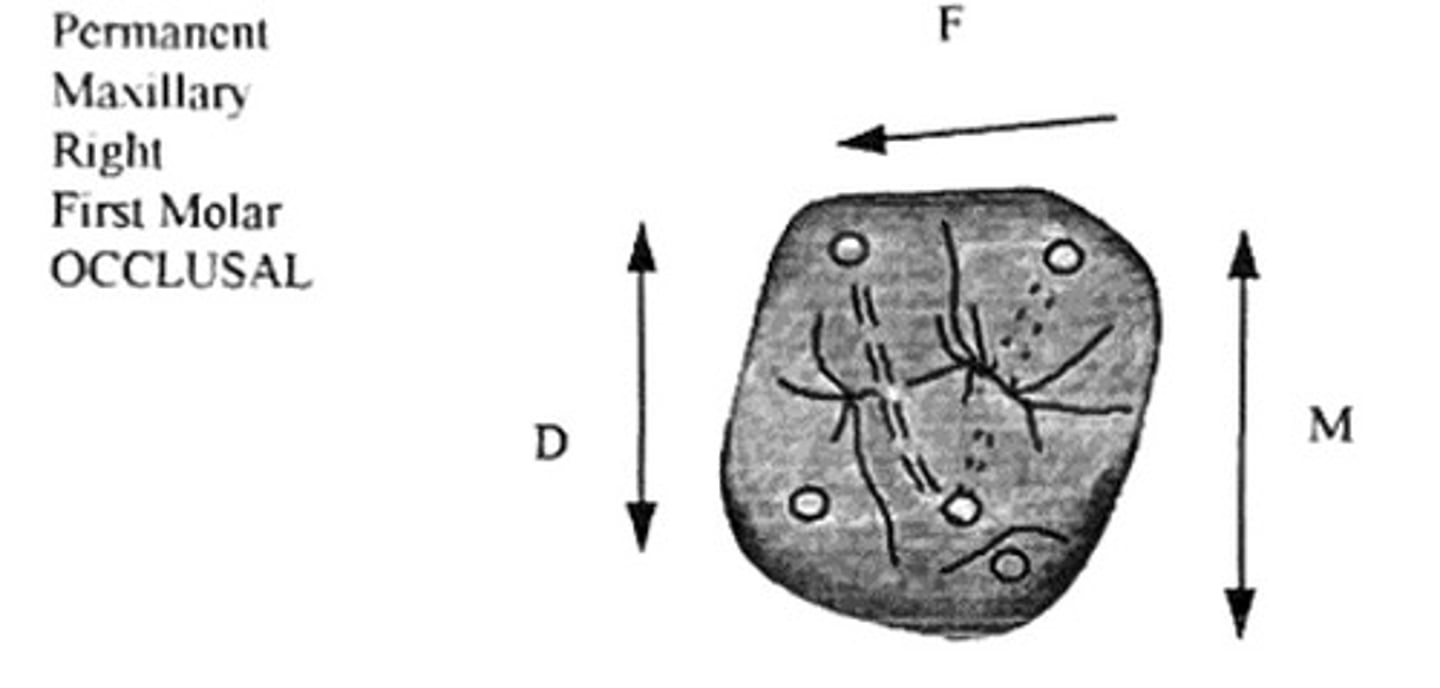
All molars: Mesial contact is located ____________.
middle third

All molars: Distal contact is located ____________.
middle third (slightly more cervical)
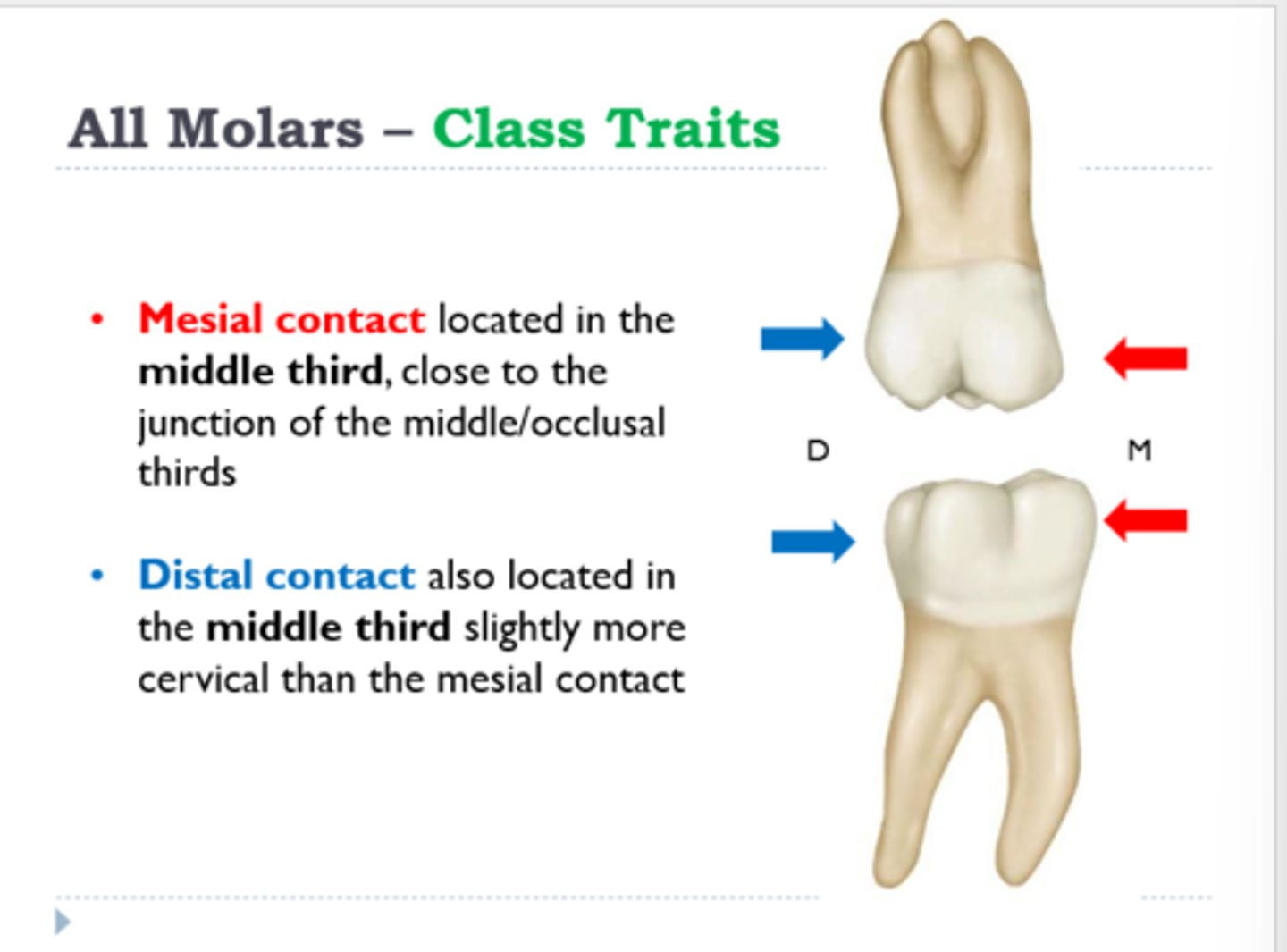
Maxillary molars have 3 roots named:
-mesiobuccal root
-distobuccal root
-lingual (palatal) root

How many cusps do molars have? (range)
3-5
Molars are the shortest teeth __________. (in what direction)
occlusocervically
Occlusal view: All molar crowns have a buccal to lingual taper EXCEPT:
maxillary first molar with large distolingual cusp
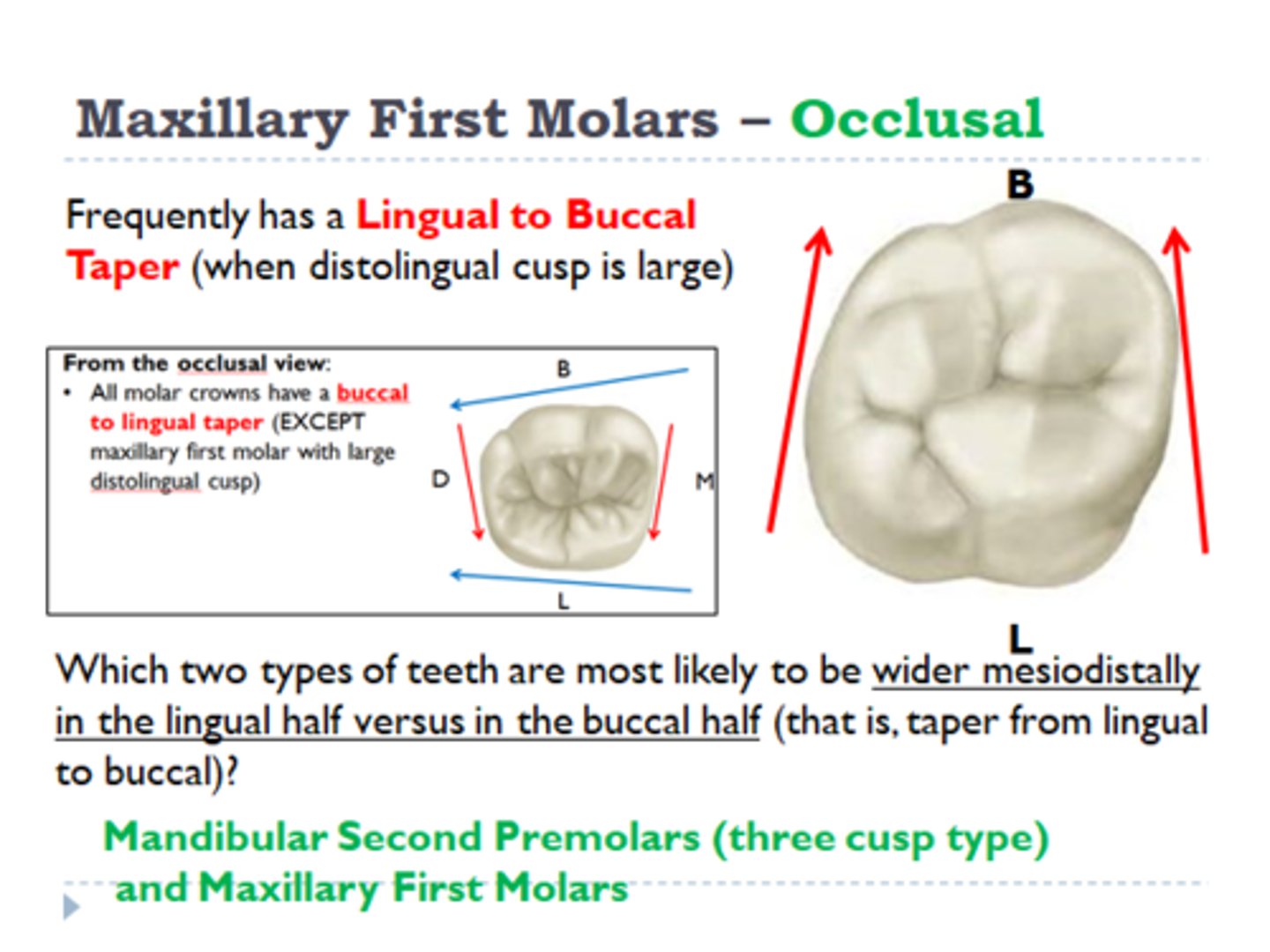
Buccal height of contour is located:
cervical third (as on all teeth)
Think: BC - Before Christ - buccal, cervical
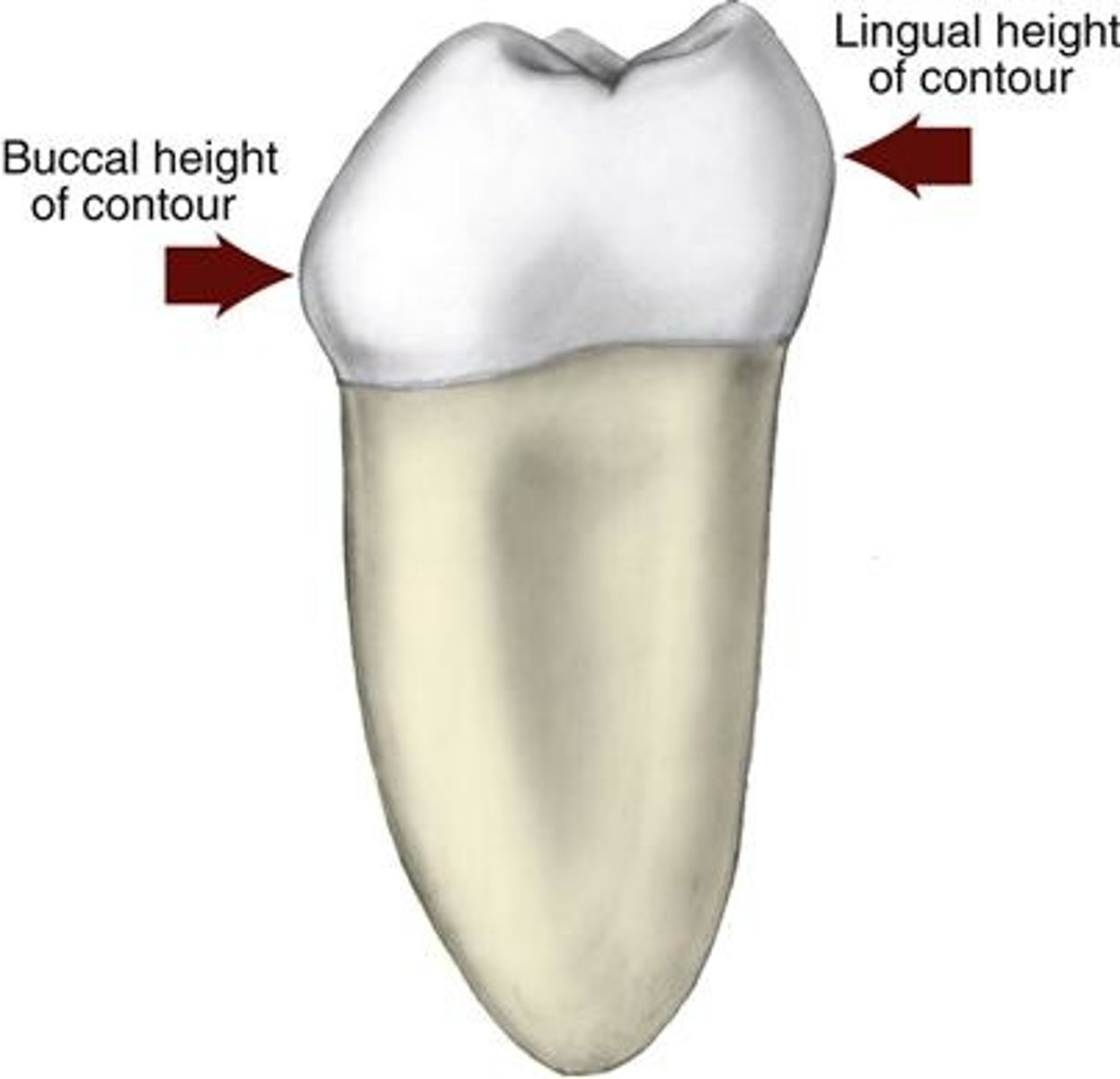
Lingual height of contour is located:
middle third (as on all posterior teeth)
Think: LM - Like Mike - lingual, middle

Occlusal view: __________ dimension is wider than mesiodistal dimension.
faciolingual
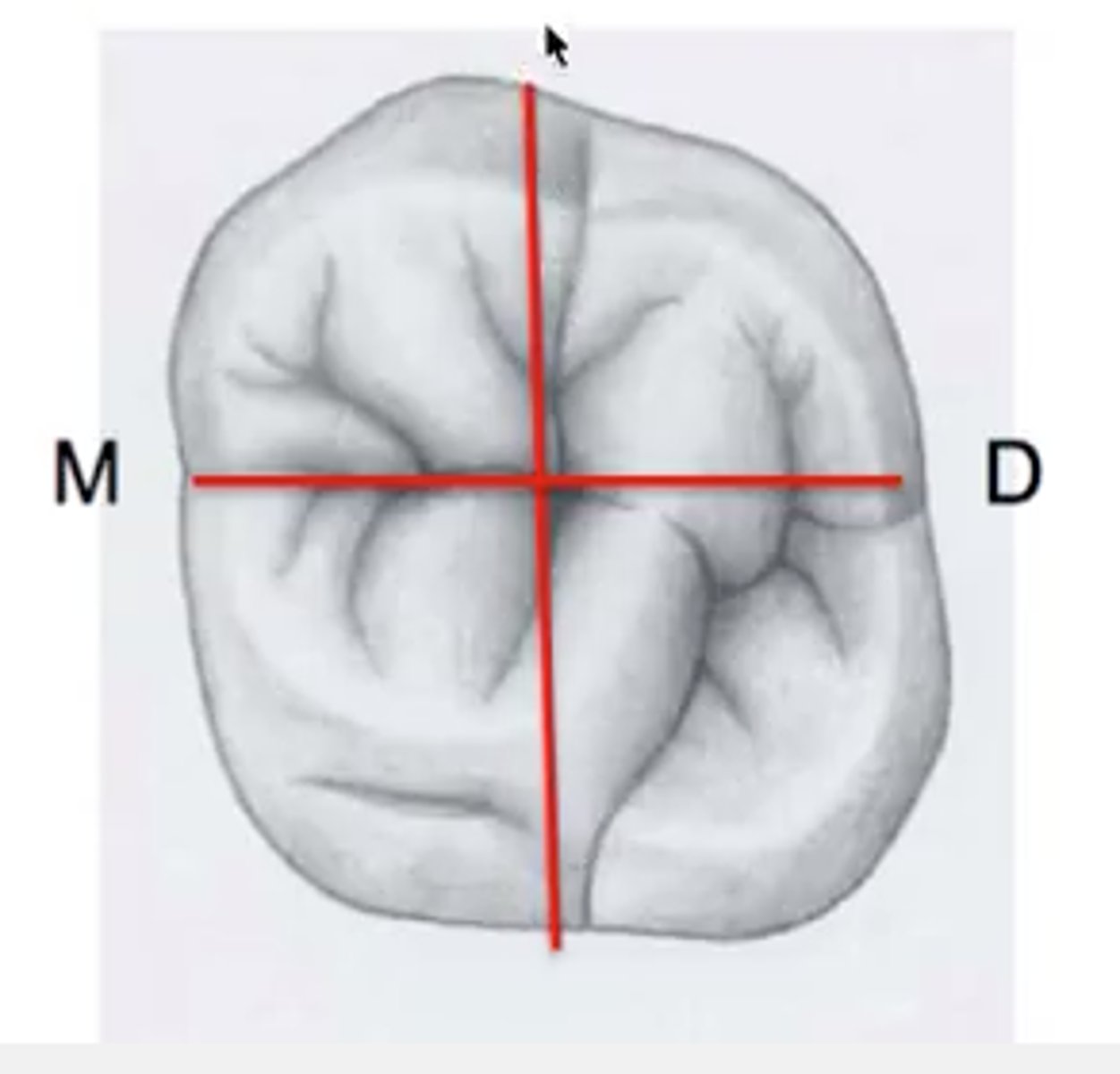
Occlusal view: The ___________ gets progressively smaller on the second and third maxillary molars.
distolingual cusp
Occlusal view: The distolingual cusp is classified as a ____(a.)_____ cusp, as it's not part of the ____(b.)______ or ___(c.)______.
a. talon
b. primary cusp triangle
c. trigon
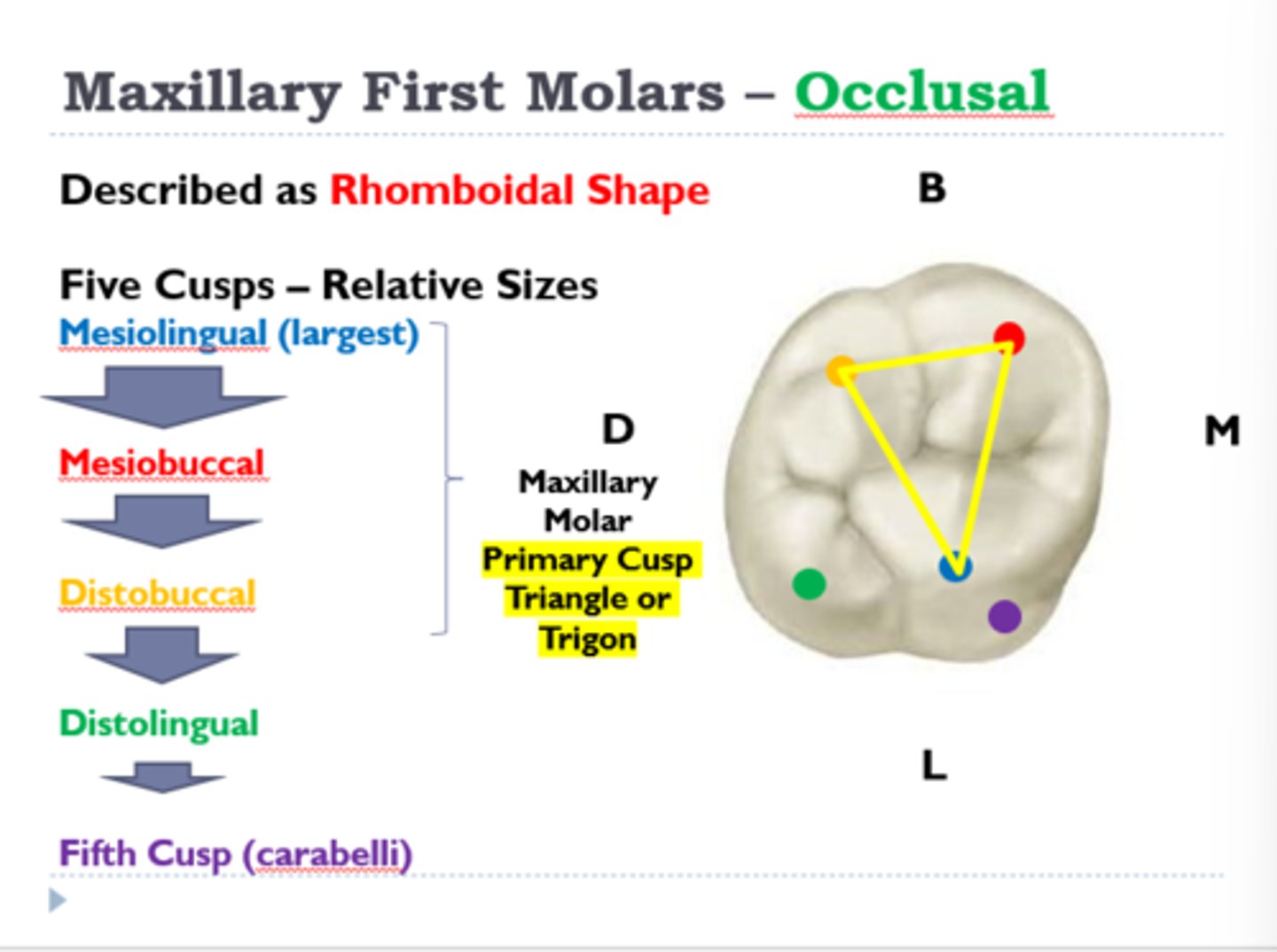
Age of eruption for 1st molar
6 - 7 years
Age of eruption of 2nd molar
12- 13 years
Age of eruption of 3nd molar
17 - 21 years
1st molar, buccal view: What root curves distally at the middle third?
Mesiobuccal
1st molar: What root is straight from the buccal view?
palatal
1st molar: What root is the longest of the 3 roots?
palatal
1st molar, lingual view: carabelli's cusp location
lingual aspect of the mesiolingual cusp
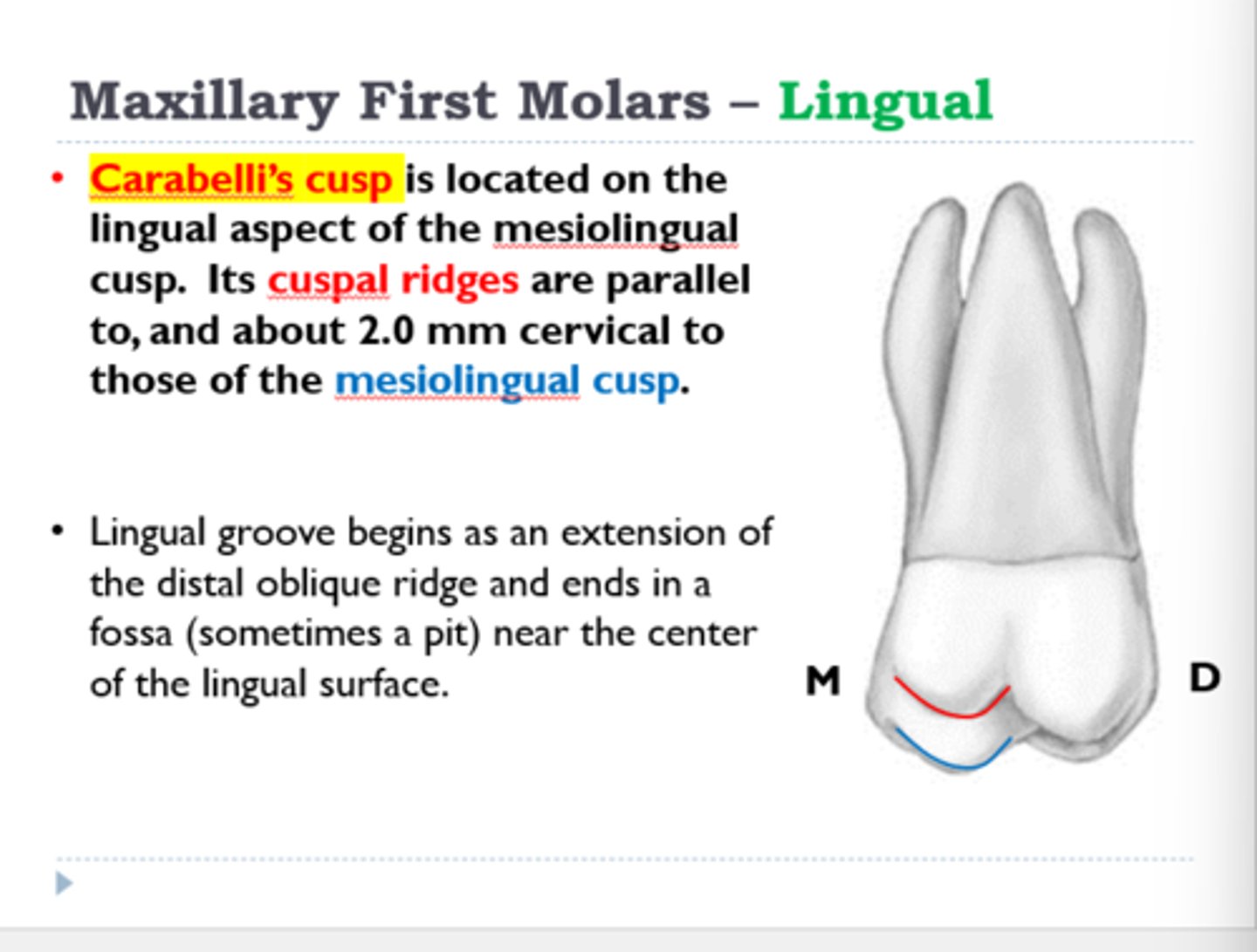
1st molar, lingual view: carabelli's cusp is parallel to ___________________.
mesiolingual cusp
1st molar: where does the lingual groove begin and end?
begins: extension of the distal oblique groove
ends: in a fossa (sometimes a pit) near the center of the lingual surface
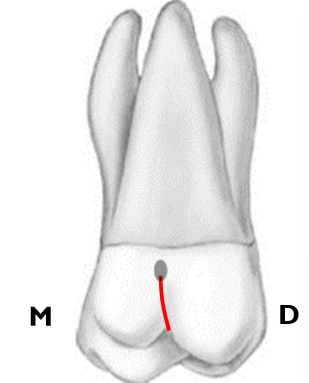
1st molar: in what direction is the mesiobuccal root much wider and slightly longer than the distobuccal root?
faciolinugally
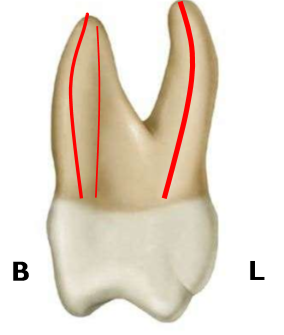
1st molar: why is the mesiobuccal root often wider?
second canal space
What is mesiobuccal #2? Another name for mesiobuccal #2?
the second canal space found in the mesiobuccal root that makes the mesiobuccal root wider Facio lingually than the distobuccal, MB2
1st molar, occlusal view: list the 5 cusps from largest to smallest
1. Mesiolingual (largest) -- ML
2. Mesiobuccal -- MB
3. Distobuccal -- DB
4. Distolingual -- DL
5. 5th cusp (Carabelli) -- C
Most Line Backers Don’t Beat Lion Cubs
1st molar, occlusal view: which cusps make up the primary cusp triangle or tigon?
mesolingual, mesiobuccal, distobuccal
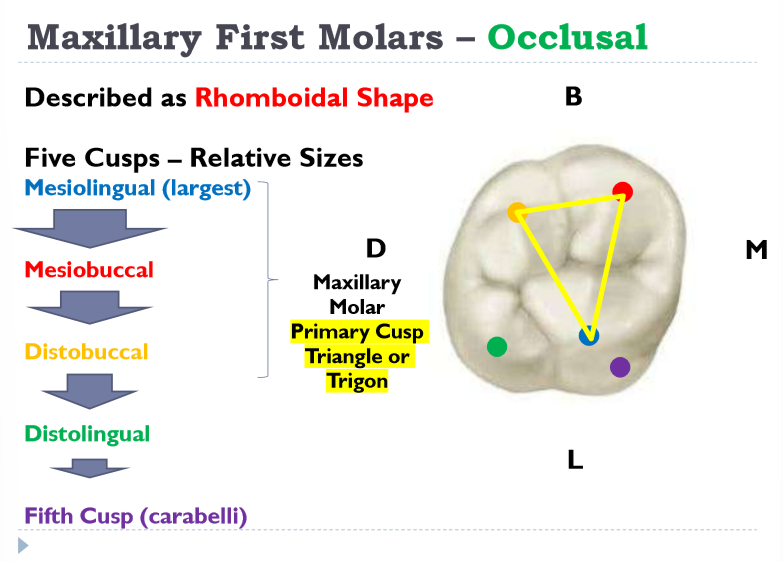
Which 2 types of teeth are most likely to be wider mesiodistally in the lingual half vs. the buccal half? (taper from lingual to buccal)
Mandibular 2nd premolars (three cusp type) and maxillary first molars
1st molar, occlusal view: Ridge that extends from the tip of the mesiolingual cusp, across the tooth to the tip of the distobuccal cusp?
oblique ridge (characteristic of ALL maxillary molars)
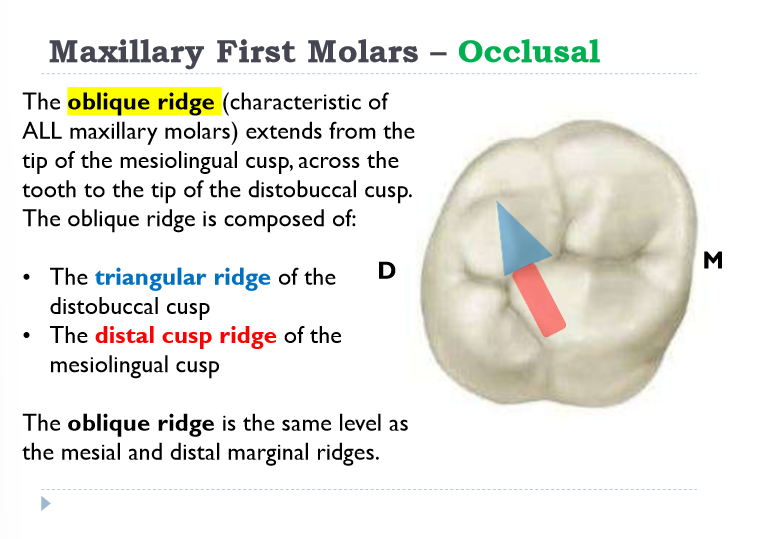
The oblique ridge is composed of: (2 answers)
-Triangular ridge of the DistoBuccal cusp (Think: Touch Down Baby!)
-Distal cusp ridge of the Mesiolingual cusp (Think: DM = dark magic)
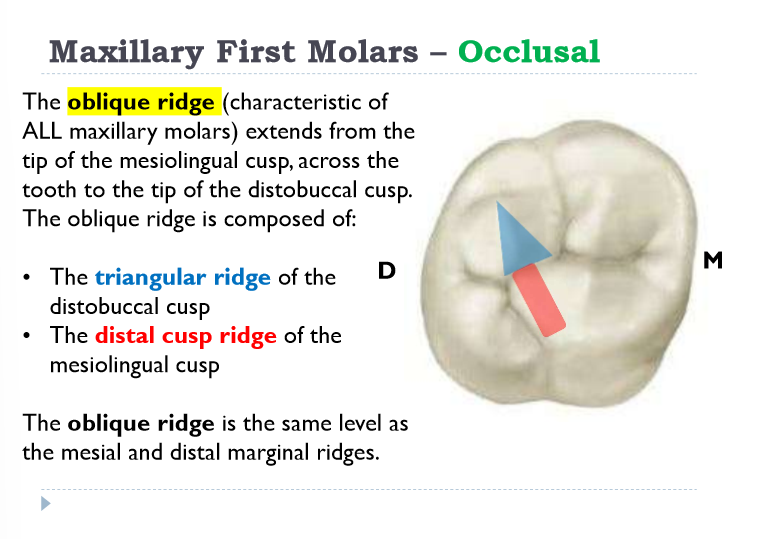
1st molar, occlusal view: what are the 2 major fossa?
central and distal fossa
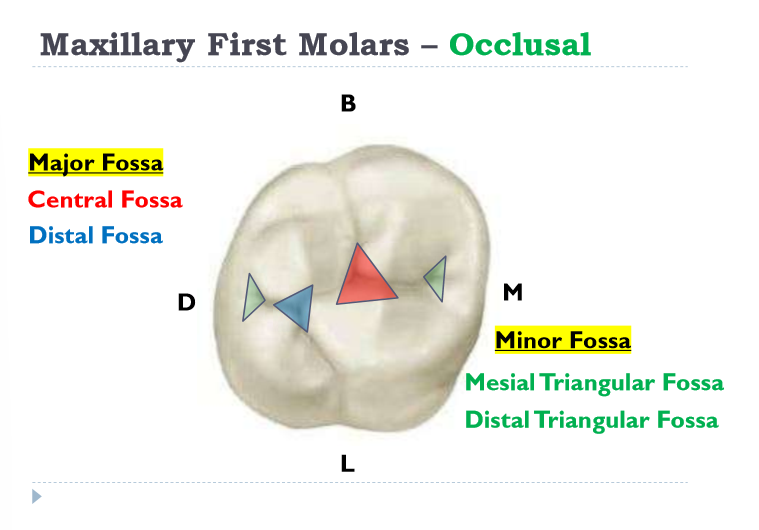
1st molar, occlusal view: what are the 2 minor fossa?
mesial triangular and distal triangular fossa
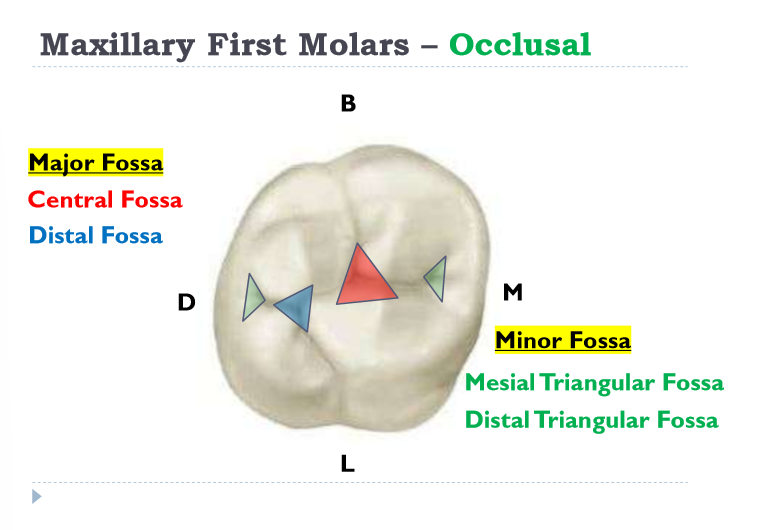
1st molar, occlusal view: List the 7 visible grooves.
-Buccal groove of the central Fossa
-Distal occlusal groove (distal oblique)
-Transverse groove of the oblique ridge
-Lingual groove
-5th cusp groove
-Central groove of the central fossa
-buccal groove
(Think: BF David Took Like 5 Crazy Badgers)
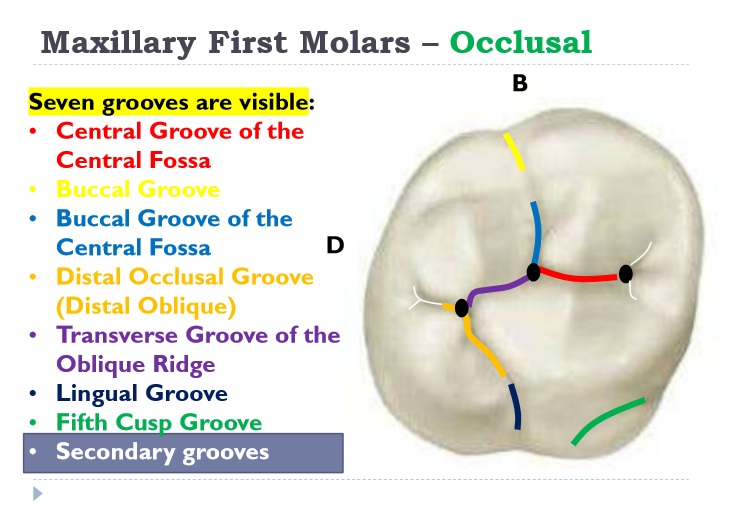
What is a first molar deformity caused by congenital syphilis?
Mulberry Molars
2nd molar, occlusal view: Shape of tooth?
Rhomboidal (for larger distolingual cusp) or heart shaped (smaller distolingual cusp ) - depending on the size of the distolingual cusp if missing the DL cusp, developed from 3 lobes
What tooth is most likely to never form and has the most variation in root and crown form of all permanent teeth?
Maxillary 3rd molar
What tooth has the most supplemental grooves?
Maxillary 3rd molar
All molar crowns have a buccal to lingual taper except:
Maxillary first molar
When looking from the occlusal or incisal view, which tooth would be wider in the Faciolingual dimension than the mesiodistal dimension?
a. #18
b. #30
c. #9
d. #14
d. #14
All the following statements are true about maxillary third molars except:
a. Tooth least likely to form
b. Least amount of supplemental grooves compared to 1st and 2nd maxillary molars
c. Can range from rhomboidal to heart shaped from the occlusal view
d. Smaller in all dimensions than the other maxillary molars
b. Least amount of supplemental grooves compared to 1st and 2nd maxillary molars
The root most likely to have two canals is:
a. #3 MB
b. #3 DB
c. #3 P
d. #2 DB
a. #3 MB
All of the following are named fossa on maxillary first molars except:
a. Mesial triangular fossa
b. Distal triangular fossa
c. Central fossa
d. Distal fossa
e. None of the above
e. None of the above
Maxillary 1st molars typically have a fifth cusp called the cusp of ___.
Carabelli
The oblique ridge of the maxillary 1st molars is formed by the ___(a.)___ and __(b.)__.
a. The triangular ridge of the distobuccal cusp
b.the distal cusp ridge of the mesiolingual cusp